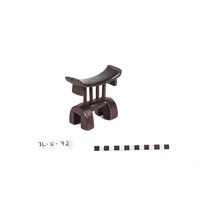Metadata
Headrest
[ Source of title : Nessa Leibhammer using JAG materials ]
Object
Textual record
Johannesburg Art Gallery (JAG)
JL-E-72
Creative Commons License: CC BY-NC-ND
https://creativecommons.org/licenses/by-nc-nd/3.0/
Unless otherwise stated the copyright of all material on the FHYA resides with the contributing institution/custodian.
Description
[Source - Debra Pryor for FHYA, 2022, using spreadsheet created by Nessa Leibhammer for the South African Heritage Resources Information System (SAHRIS), from JAG materials in 2015: Object description: Crossbar curved up towards narrow ends with a line of zig-zags carved at either flattened ends. Lugs are flat rectangular flaps facing inward. Four round pillars rest on the back of a semi-cylindrical base with four legs at either corner.
Object code: JL-E-72;
Object common name: headrest;
Object local name: xikhigelo;
Object form type: headrest;
Object material type: wood; U5
Technique: carving;
Colours: Brown;
Inscriptions: ;
Dimension comment: 12,7 x 12,6 x 6,5;
objectage: 19th to early 20th century;
Production place: Limpopo Province/Mozambique;
Cultural association: Tsonga;
Place of use: Limpopo Province/Mozambique;
Provenance: .]
Attributions and conjectures
[Source - Nessa Leibhammer for FHYA, 2017: Comments on classification: In his 'A Preliminary Survey of the Bantu Tribes of South Africa', Union of South Africa, Department of Native Affairs, Ethnological Publications, Vol. 5, Pretoria, Government Printer, (1935): 7, 70-83, national government ethnologist, Nicholas Van Warmelo did not use the term "North Nguni". He grouped people living both north and south of the Thukela, under one umbrella term, "Natal Nguni", based on linguistic affinity. His classification was adapted by the ethnology curator, Margaret Shaw, in her 1958 "System of Cataloguing Ethnographic Material in Museums" which determined that items from the region were to be classified as "Natal Nguni: Zulu and others (not differentiated)."
According to art historian, Anitra Nettleton, the classificatory system used by art galleries and museum shifted from Shaw's model to the one where "Natal Nguni" fell away and was replaced by "North/Northern Nguni" for KwaZulu-Natal and Swaziland because scholars found it difficult to distinguish items from adjacent areas, or emigrant people from those from the KZN region. Scholars working with the JAG materials used broad ethno-linguistic categories (Zulu, Xhosa, Tsonga, Shona, Sotho, Tswana) to identify the makers/users of the objects, all of which came to JAG without much by way of provenance, and identification was based on factors such as object type, materials, formal composition, style and surface patterning (emails A. Nettleton to N. Leibhammer, 25 and 28 November 2014).
Jonathan Lowen employed Margaret Carey, a British ethnologist, to catalogue his collection in the winter of 1983-84. She classified many of the objects as 'Zulu' (sic) simply because of a lack of information about the objects. (Rhoda Rosen citing Sandra Klopper.)]
If you have difficulty accessing the objects, use these links.

Contributions